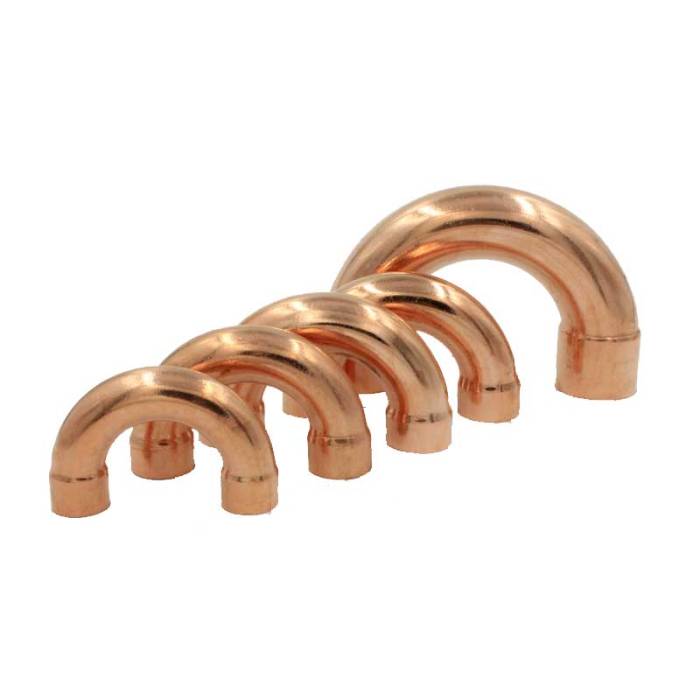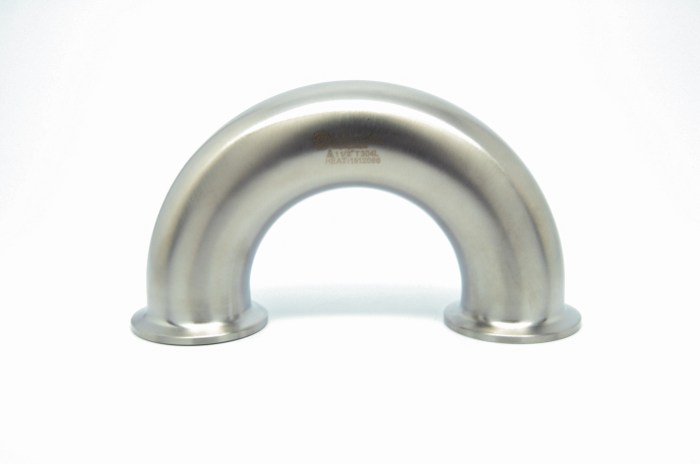For the 180 degree elbow and nozzle – The 180-degree elbow and nozzle, a crucial component in various industrial applications, offers unique advantages and considerations in design, manufacturing, and installation. This article provides a comprehensive overview of this essential component, exploring its purpose, materials, and design factors, as well as the manufacturing processes and quality control measures involved in its production.
Furthermore, the discussion encompasses the proper installation and maintenance procedures, highlighting the importance of alignment and support for optimal performance. The diverse applications of the 180-degree elbow and nozzle are also examined, showcasing its versatility and the specific benefits it offers in each industry.
Introduction to the 180-Degree Elbow and Nozzle

A 180-degree elbow and nozzle is a specialized piping component used in various industrial and commercial applications. It consists of a 180-degree elbow, which is a pipe fitting that changes the direction of a pipe by 180 degrees, and a nozzle, which is a device designed to control the flow and shape of a fluid.
The 180-degree elbow and nozzle combination serves several purposes, including changing the direction of fluid flow, reducing turbulence, and providing a controlled discharge of fluids. These components are commonly employed in piping systems for water, gas, steam, and other liquids or gases.
Materials Used
The materials used in the construction of 180-degree elbows and nozzles vary depending on the intended application and the properties required. Common materials include:
- Steel:Durable and strong, suitable for high-pressure and high-temperature applications.
- Stainless steel:Resistant to corrosion and chemicals, ideal for sanitary and food processing applications.
- Copper:Malleable and ductile, used in plumbing and heating systems.
- PVC (Polyvinyl Chloride):Lightweight and corrosion-resistant, suitable for low-pressure applications.
- CPVC (Chlorinated Polyvinyl Chloride):Similar to PVC, but with higher temperature resistance.
Advantages and Disadvantages
Using a 180-degree elbow and nozzle offers several advantages:
- Directional change:Allows for precise changes in the direction of fluid flow.
- Turbulence reduction:The nozzle helps to streamline the flow, reducing turbulence and pressure drop.
- Controlled discharge:The nozzle can be shaped to control the flow rate, spray pattern, and droplet size.
However, there are also some disadvantages to consider:
- Pressure loss:The elbow and nozzle can introduce some pressure loss due to friction and flow disturbances.
- Cost:These components can be more expensive than standard pipe fittings.
- Maintenance:The nozzle may require regular cleaning or replacement to maintain optimal performance.
Design Considerations: For The 180 Degree Elbow And Nozzle
The design of a 180-degree elbow and nozzle is critical to ensure efficient and safe operation. Several factors need to be considered during the design process, including flow rate, pressure, temperature, corrosion resistance, and wear resistance.
The flow rate through the elbow and nozzle will determine the size and shape of the components. The pressure rating of the system will determine the thickness of the materials used. The temperature of the fluid flowing through the system will determine the materials that can be used.
Corrosion Resistance
The materials used in the construction of the elbow and nozzle must be resistant to corrosion from the fluid flowing through the system. The type of fluid and the operating temperature will determine the level of corrosion resistance required.
Wear Resistance
The materials used in the construction of the elbow and nozzle must also be resistant to wear from the fluid flowing through the system. The type of fluid and the operating conditions will determine the level of wear resistance required.
Manufacturing Processes
The manufacturing of 180-degree elbows and nozzles involves several processes, each with its advantages and disadvantages. These processes include casting, forging, and fabrication.
Casting is a process where molten metal is poured into a mold and allowed to solidify. This process is suitable for producing complex shapes and is often used for large-scale production. However, casting can result in defects such as porosity and shrinkage.
Forging
Forging involves shaping metal by applying pressure or hammering. This process is used to produce high-strength components and can improve the grain structure of the metal. However, forging is limited to simpler shapes and can be more expensive than other processes.
Fabrication
Fabrication involves cutting, bending, and welding metal sheets or plates to form the desired shape. This process is suitable for producing custom-sized components and is relatively inexpensive. However, fabrication can result in weaker joints compared to other processes.
Quality control measures are implemented throughout the manufacturing process to ensure the quality of the final product. These measures include visual inspection, dimensional checks, and non-destructive testing.
Installation and Maintenance

Proper installation and maintenance are crucial for the optimal performance and longevity of a 180-degree elbow and nozzle. Installing the elbow and nozzle correctly ensures proper alignment and support, preventing leaks, premature wear, and potential safety hazards.
Installation, For the 180 degree elbow and nozzle
- Clean the mating surfaces of the elbow and nozzle thoroughly to remove any debris or contaminants.
- Apply a thin layer of sealant or gasket material to the mating surfaces to ensure a leak-proof seal.
- Align the elbow and nozzle carefully and hand-tighten the connection. Do not overtighten, as this can damage the components.
- Use a torque wrench to tighten the connection to the manufacturer’s specified torque.
- Check the alignment of the elbow and nozzle after tightening to ensure it is straight and perpendicular to the pipe.
Maintenance
Regular maintenance is essential to ensure the elbow and nozzle remain in good working condition. The following maintenance procedures are recommended:
- Inspect the elbow and nozzle regularly for signs of wear, corrosion, or damage.
- Clean the elbow and nozzle periodically to remove any accumulated debris or deposits.
- Check the tightness of the connection regularly and retighten if necessary.
- Replace the elbow or nozzle if it becomes damaged or worn beyond repair.
Applications

The 180-degree elbow and nozzle finds applications in various industries, including chemical processing, pharmaceuticals, food and beverage, and power generation. Its unique design offers specific benefits in each of these applications.
Chemical Processing
In chemical processing, the 180-degree elbow and nozzle is used to handle corrosive and hazardous chemicals. Its smooth interior surface prevents the accumulation of solids and reduces the risk of clogging. Additionally, the nozzle’s directional flow pattern ensures efficient mixing and reaction within process vessels.
Pharmaceuticals
Within the pharmaceutical industry, the 180-degree elbow and nozzle is employed for sterile fluid handling. Its crevice-free design minimizes the potential for contamination and ensures compliance with strict regulatory standards. The nozzle’s ability to direct flow precisely enables accurate filling and dispensing of pharmaceutical products.
Food and Beverage
The food and beverage industry utilizes the 180-degree elbow and nozzle for hygienic fluid transfer. Its smooth surface and crevice-free design prevent the growth of bacteria and ensure product safety. The nozzle’s ability to control flow direction facilitates efficient filling and packaging of food and beverage products.
Power Generation
In power generation plants, the 180-degree elbow and nozzle is used for cooling and steam distribution. Its robust construction withstands high pressures and temperatures, ensuring reliable operation. The nozzle’s directional flow pattern optimizes heat transfer and reduces pressure drop within cooling systems.
Troubleshooting
Troubleshooting a 180-degree elbow and nozzle involves identifying and resolving common problems associated with their operation. Regular inspections and preventive maintenance are crucial for ensuring optimal performance and longevity.
Common problems may include:
- Flow restrictions:Clogging or blockages in the elbow or nozzle can restrict fluid flow. Inspect and clean the components regularly.
- Leaks:Check for leaks at joints, seals, or cracks. Tighten loose connections and replace damaged components.
- Erosion or corrosion:Exposure to abrasive or corrosive fluids can damage the elbow and nozzle. Use corrosion-resistant materials and implement protective measures.
- Vibration:Excessive vibration can lead to component failure. Ensure proper alignment and support to minimize vibrations.
- Temperature fluctuations:Sudden temperature changes can cause thermal stress and damage. Use materials suitable for the operating temperature range.
Regular inspections and preventive maintenance are essential for early detection of potential problems and to extend the lifespan of the elbow and nozzle. These include visual inspections, cleaning, lubrication, and periodic replacements of worn components.
Popular Questions
What are the common materials used in the construction of 180-degree elbows and nozzles?
Stainless steel, carbon steel, and alloys such as brass and bronze are commonly used materials due to their durability, corrosion resistance, and ability to withstand high pressures and temperatures.
What factors should be considered when designing a 180-degree elbow and nozzle?
Flow rate, pressure, temperature, corrosion resistance, and wear resistance are key factors that influence the design of a 180-degree elbow and nozzle.
What are the different manufacturing processes used to produce 180-degree elbows and nozzles?
Casting, forging, and machining are the primary manufacturing processes used, each with its own advantages and disadvantages.